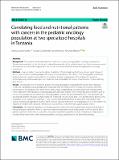| dc.description.abstract | Background
This study of nutritional patterns in relation to cancers among pediatric oncology population in Tanzania was motivated by the lack of up-to-date information about the nutritional practices, the controversy around the importance of nutritional support and the lack of consistent nutritional criteria among pediatric oncology populations.
Methods
A survey study in two cancer referral hospitals of children diagnosed with any cancers, aged between 1 and 17 years inclusive and being eligible for enteral feeding included 131 children. Their demographic, nutritional, feeding and cancer profiles were analyzed descriptively through mapping and other approaches as well as inferentially using multinomial regression models to understand different aspects of nutrition for children suffering from cancers.
Results
The majority (15% or higher) of pediatric oncology population originated from the lake zone. Between 7 and 12% of pediatric oncology population originated from the Western zone. The top-three cancers with their percentages in the brackets were: Wilms Tumor (32%), Acute Lymphoblastic Leukemia (26%) and Retinoblastoma (13%). About 69% of the pediatric oncology population ate foods that are rich in energy but poor in protein such as rice (21.5%), porridge (19.3%), banana (11.7%) and potatoes (10.2%). On the other hand, only 17.5% ate foods that are generally protein-rich such as meat (8.0%), fish (5.3%) and chicken (4.2%); and 12.7% ate milk (4.2%), beans (3.4%), vegetables (2.7%), eggs (1.9%) and fruits (1.5%). Cancers impacted food intake in about 60% of all children with cancers and affected appetite in 18.3% of them. Cancers caused vomiting in 16% and diarrhea in 6.1% of children. The majority of children with cancers (61.8%) took at least one meal while 34.4% took just snacks (p < 0.001).
Conclusions
The majority of pediatric oncology population had erratic nutritional patterns and took foods high in energy and poor in proteins. There is a two-way interaction between cancers and nutrition in which cancers affect general nutritional intake which could affect the cancer treatment outcomes in return. Therefore, it is important to consider these interactions while managing pediatric oncology populations in this and similar settings. | en_US |

